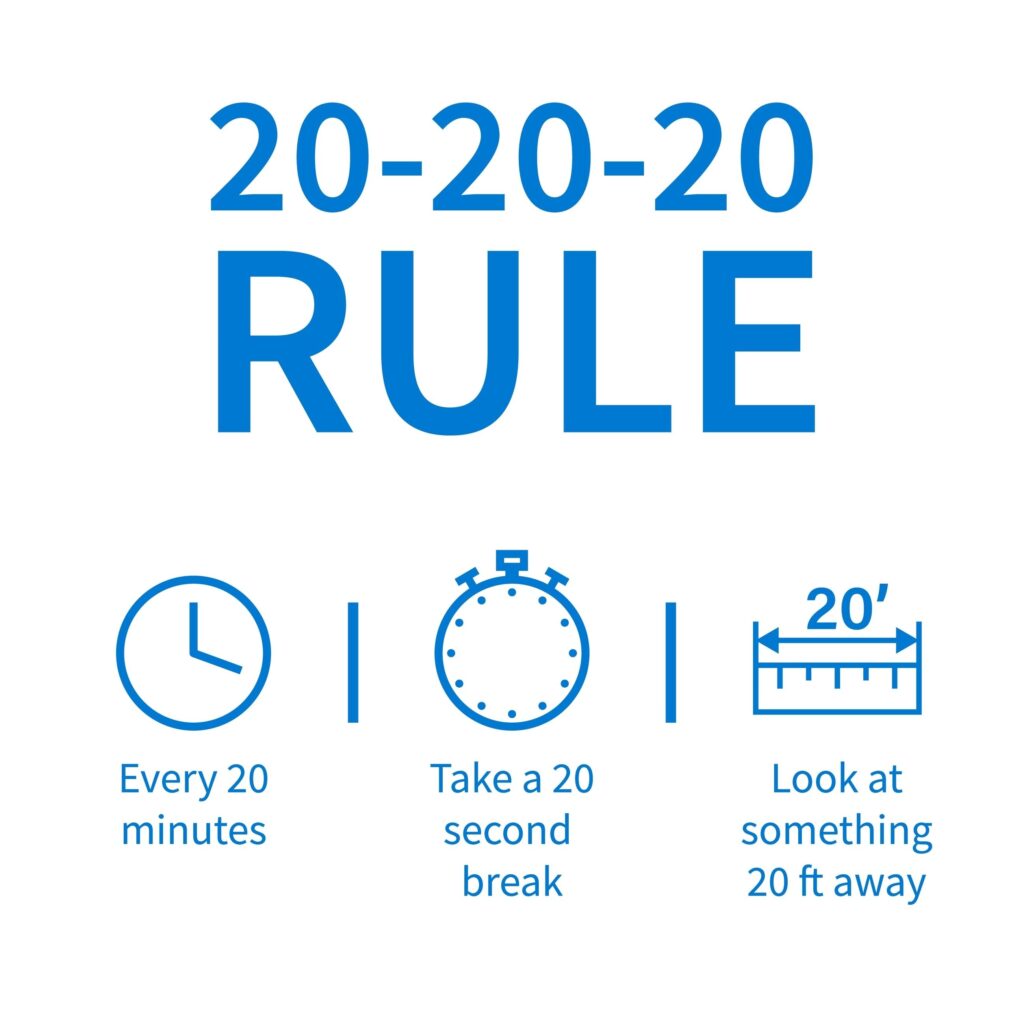You rub your neck after a long day at your desk. A familiar headache starts to creep in, and your vision feels a little fuzzy. You might blame your chair or the long hours, but the real cause could be hiding in plain sight. As eye doctors, we often see how underlying vision needs affect your body.
These three seemingly separate symptoms are often connected by how your posture, screen use, and underlying vision needs affect your body. An imbalance in one area can create a ripple effect of discomfort. Understanding this connection, and what happens during a routine eye exam, is the first step toward finding relief.
The Connection Between Your Neck, Eyes, & Head
You might not think your neck and eyes are related, but they often work together in ways that can lead to discomfort. When your eyes are slightly misaligned, your brain works overtime to create a single, clear image. To help with this, you may unconsciously tilt your head, which puts a constant strain on your neck muscles.
How Eye Misalignment Affects Your Posture
A small tilt of your head might not seem like a big deal, but over time it can cause the muscles in your neck and shoulders to become sore and tight. This can lead to persistent neck pain, stiffness, and a reduced range of motion. Constant muscle tension is a common source of headaches that seem to come out of nowhere.
Key Neck Muscles & Their Role in Headaches
Certain muscles are often a source of tension. When these muscles are overworked from poor posture or eye strain, they can trigger pain that you feel in your head or behind your eyes.
- Trapezius: A large muscle that extends from the base of your skull down your neck and across your shoulders. Tension here often feels like a dull, aching pain.
- Suboccipital Muscles: A small group of muscles at the base of the skull that helps with fine head movements. Tightness in this area can create a band-like pressure around your head.
- Sternocleidomastoid (SCM): Runs from behind your ear down to your collarbone. Strain in the SCM can refer pain to your forehead and temples.
What Is a Cervicogenic Headache?
A cervicogenic headache is pain that starts in your neck but is felt in your head. It’s different from a migraine because it comes from issues in your cervical spine, often linked to the physical stress caused by digital eye strain. This type of headache is often one-sided and can be brought on by certain neck movements or positions.
Common Causes of These Symptoms
Beyond posture and eye alignment, several everyday factors can trigger neck pain, blurry vision, and headaches all at once. Recognizing these triggers can help you connect your symptoms to your daily activities. Many common activities and conditions can contribute to this trio of discomfort.
Digital Eye Strain & Screen Time
Looking at screens for hours forces your eyes to work harder to focus. This overuse can tire your eye muscles, leading to a collection of symptoms often called digital eye strain. You might notice these after a long day of computer work or scrolling on your phone.
- Headaches that start behind the eyes
- Blurry vision or difficulty focusing
- Dry, irritated eyes
- Increased light sensitivity
Migraine & Cluster Headaches
Migraines can cause intense, throbbing pain that is often accompanied by visual changes. You might experience an aura before the headache starts, which can include blurry vision or seeing flashing lights. Cluster headaches are severe and often cause pain around one eye, along with tearing or redness.
Vision Changes Like Farsightedness & Presbyopia
If you have hyperopia (farsightedness), your eyes have to strain to see things up close, which often leads to headaches and blurry vision, especially while reading. Presbyopia is a similar condition that happens as you get older. It makes focusing on nearby objects difficult and can cause similar symptoms.

Simple Tips for Relief & Prevention
You can take proactive steps to reduce the frequency and intensity of these symptoms. Small changes to your daily routine can make a big difference. These simple habits can help relieve the strain on both your eyes and your neck.
Create an Ergonomic Workspace
Adjust your chair, desk, and monitor to support good posture. Your computer screen should be positioned slightly below eye level. Along with other factors like screen brightness, proper ergonomics are more important for reducing eye strain than simply switching to dark mode.
Practice the 20-20-20 Rule
To combat digital eye strain, take a break every 20 minutes. The 20-20-20 rule suggests you look at something at least 20 feet away for a full 20 seconds. This gives your eye muscles a chance to relax and refocus.
Improve Your Posture Habits
Be mindful of how you sit and stand throughout the day. Try to keep your shoulders back and your head aligned over your spine. This is especially important when you’re looking down at your phone or another device.
How a Comprehensive Eye Exam Can Help
If you regularly experience neck pain, blurry vision, or headaches, a comprehensive eye exam is a good step to take. It can help identify if a vision issue is contributing to your discomfort. A thorough checkup provides a clear picture of your eye health.
Check for Underlying Vision Problems
An eye exam with an eye doctor in San Clemente can determine if an uncorrected vision issue, like farsightedness, is forcing your eyes and neck muscles to work overtime. Recognizing the signs of an incorrect prescription is key, as an updated one can often provide significant relief. It helps your eyes focus properly without the extra effort.
Assess Your Eye Alignment
Professional testing can measure how well your eyes work together as a team. If a misalignment is found, custom aligning lenses—like Neurolens glasses, which make use of prism technology—can help correct the issue. This can reduce the need to tilt your head and may relieve chronic neck strain.
Your Local Eye Doctor & Long-Term Vision Health
Regular eye care is a key part of health for every member of your family. It helps address current symptoms and supports your long-term vision. A routine visit to an eye doctor can help uncover the root cause of your discomfort.
You don’t have to accept neck pain, blurry vision, and headaches as a normal part of your life. Understanding the connection between them is a powerful tool. A comprehensive eye exam can offer clarity and a path toward feeling better.
At Griffin Optometric Group – Talega, we take the time to understand your unique symptoms and how they affect your daily life. We’re here to help your whole family see clearly and comfortably. Schedule a comprehensive eye exam with our eye doctor in San Clemente today.



